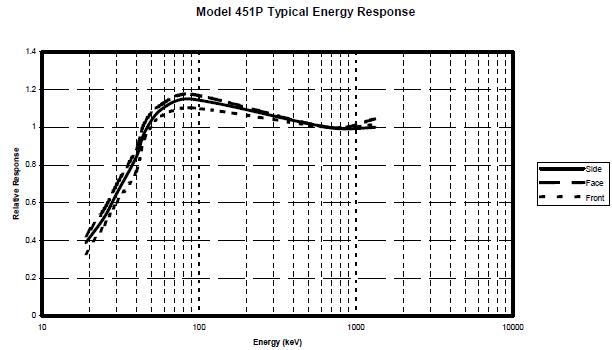451P Ion Chamber Survey Meter Radiation Detected Of Beta Above 1MeV & Gamma Above 25KeV
451P Ion Chamber Survey Meter Radiation Detected Of Beta Above 1MeV & Gamma Above 25KeV
- Model:
451P Ion Chamber Survey Meter Radiation Detected Of Beta Above 1MeV & Gamma Above 25KeV
IEC 60065:2014 clause 6.1 Ion Chamber Survey Meter
Introduction
The Model 451P Ion Chamber Survey Meter is a hand-held, pressurized, battery operated unit designed to measure gamma and x-ray radiation above 25 keV, and beta radiation above 1 MeV, using the latest CMOS and LCD technology. The 451P case is constructed of high strength ABS plastic. A gasket seals moisture out of the unit and provides a cushion for the internal components. The Model 451P readout consists of a 2 1/2 digit liquid crystal display and a 100 segment analog bargraph. The bargraph contains a zero segment and twenty groups of five segments each. A permanent scale is located on the display screen. The major divisions of the scale indicate the units corresponding to the range that the meter is measuring. Units of measurement are displayed next to the 2 1/2 digit display. LOW BAT and FREEZE will appear on the display when the instrument is operating in these modes. External controls consist of an ON/OFF button and a MODE button. The unit is auto-ranging and auto-zeroing and has an auto ON backlight. The backlight automatically comes on when the ambient light conditions fall below twilight levels. An internal factory set alarm will blink the display if the rate exceeds 5 R/hr. Two 9-volt batteries, located in the rear of the instrument, provide over 200 hours of continuous operation.
Features
1. Overrange Rate
If the instantaneous radiation rate measured by the Model 451P exceeds 5 R/h, the 'R' in 'mR/h' or the 'Sv' in 'Sv/h' displayed will blink to notify the user that a potential error in the integrated radiation value exists. The blinking will stop when the integrated value is cleared. This, however, may also clear the log data RAM.
2. Low Battery Indicator
There are about six hours of operation remaining when the LOW BATTERY indicator first becomes visible. When the LOW BATTERY indicator blinks, there is less than one hour of operation remaining.
These times are for two batteries installed and from the first occurrences of these indications. If the instrument is turned off during a low battery condition, the batteries will recover somewhat, but time of operation remaining will be less. The LCD low battery indicator is disabled during communication mode.
Be sure to use fresh batteries when calibrating this instrument.
WARNING
If chamber bias is LO, the instrument can’t measure high radiation rates accurately. Service to the instrument is required.
Verify the chamber bias is low. Turn the unit off and replace with new 9-volt batteries. Power up the unit. After the self-test, if blinking low battery reoccurs the bias is low. Refer to Section 4 Maintenance.
3. Warm-up Time
The pressured ion chamber collection potential is 105 Vdc and is derived from the 5 lithium cells. The warm-up time for an instrument that has been off 12 or more hours is about four minutes for readings less than 20 μR/h in a 10 μR/h or less background.
Specifications





